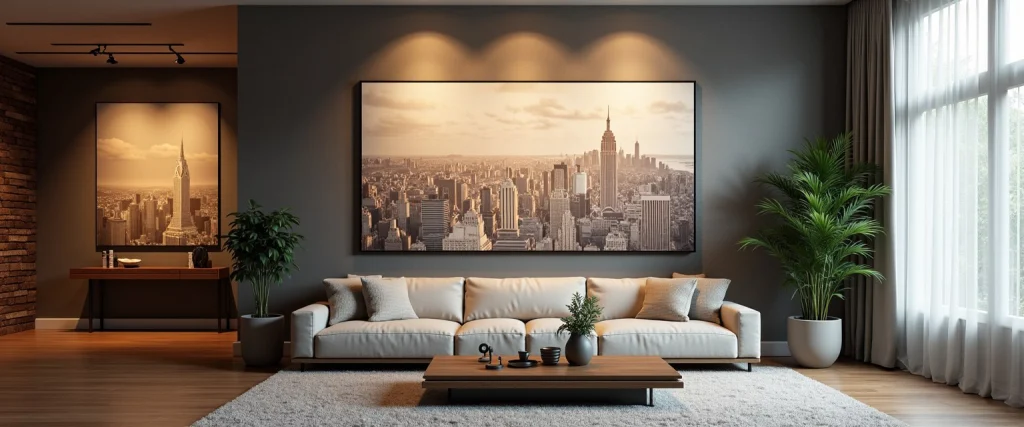Creating a gallery wall is a fantastic way to showcase art, photography, or meaningful objects and bring personality to a room. It’s a fun and creative way to personalize a space and create a visual focal point. Whether you’re decorating a living room, hallway, or even a home office, a well-curated gallery wall can turn any blank wall into a statement piece.
Steps for Creating a Gallery Wall:
- Choose Your Space:
- Pick a wall that will serve as the main focus of the room. This could be above a sofa, in a hallway, or behind a dining table.
- Consider the size of the wall. Larger walls can accommodate larger arrangements, while smaller walls may require a more concise layout.
- Decide on the Theme or Style:
- Artistic Theme: If you want to stick with a specific type of artwork, consider abstract pieces, photography, or vintage posters.
- Color Scheme: Select colors that either complement or contrast with the room’s existing decor. For example, black and white images can give a timeless feel, while bright colors can add energy.
- Eclectic: If you prefer a more varied look, mix different types of artwork, like family photos, framed quotes, and unique finds.
- Personal Touches: A gallery wall can feature your favorite quotes, meaningful family photos, postcards from travel, or even items like mirrors and small sculptures.
- Gather Your Pieces:
- Artworks: You can use original art, prints, or digital painting. Ensure your collection feels cohesive, even if the pieces vary in style or medium.
- Frames: Frames can unify a collection. You can opt for identical frames for a uniform look or vary the frame styles and sizes for a more dynamic feel.
- Non-Art Items: Don’t hesitate to include other elements, like fabric swatches, maps, or vintage objects like old records or small shelves.
- Plan the Layout:
- Grid Layout: This layout involves evenly spaced rows and columns, creating a structured, balanced design. It’s perfect for when you want the artwork to be uniform and neat.
- Salon Style: This is a more eclectic approach, where pieces are arranged to cover a large portion of the wall in an almost chaotic but aesthetically pleasing manner. The artworks can overlap and vary in sizes.
- Linear Arrangement: For a simpler, clean design, align the pieces in a straight line horizontally or vertically.
- Centered Arrangement: If you have a central piece, you can arrange the other pieces symmetrically around it to create balance.
- Layout Tools:
- Mock It Up: Lay your artwork on the floor or use painter’s tape on the wall to visualize the layout. This allows you to experiment with spacing and alignment before making any holes in the wall.
- Paper Templates: Cut out paper the size of your frames and tape them to the wall. This is a great way to test different arrangements and avoid mistakes.
- Spacing: In general, aim for 2-3 inches of space between frames. You can adjust this depending on the overall effect you’re aiming for.
- Hang the Artwork:
- Start with the center piece or the largest piece of art. This will be your anchor and help guide the placement of the other items.
- Use picture-hanging hardware that suits the weight of your frames. For heavier frames, you may need picture hooks or nails; for lighter frames, adhesive strips can work.
- Height: Ideally, the center of the gallery should be at eye level, about 57-60 inches from the floor.
- Final Touches:
- Once everything is hung, step back and take a look. You might need to adjust the spacing or move some pieces around.
- If you feel the wall is too heavy with just frames, add texture or dimension by including smaller shelves or hanging other decorative elements like plants or small sculptures.
Tips for Success:
- Consistency: While the layout may be diverse, keeping some consistency across the pieces (like using similar frames or sticking to a common color palette) can prevent the wall from feeling chaotic.
- Personalization: Your gallery wall doesn’t have to be just about art. You can mix in personal mementos, like travel souvenirs, postcards, or handwritten notes, for a unique touch.
- Scale: Larger walls can accommodate bigger frames, while smaller walls will look more balanced with smaller pieces.
- Ideas for Gallery Wall Content:
- Photography: Display personal photos or images that tell a story, such as family portraits, travel photos, or nature shots.
- Art Prints: From contemporary to vintage, prints can add texture, color, and sophistication to a space.
- Mixed Media: Combine different textures like embroidery, fabric, or small sculptures with traditional frames.
- Mirrors or Decorative Objects: Small mirrors, clocks, or even hats or vintage tools can add depth and interest to your gallery wall.
- Maintenance:
- Adjust Over Time: Feel free to change out pieces as your style evolves or as you collect new items. A gallery wall should be a flexible reflection of your personality.
- Avoid Clutter: Be mindful not to overcrowd the wall. Sometimes less is more, and leaving some space can help the design breathe.
- A gallery wall is a creative, customizable way to inject personality and warmth into any room, and with the right mix of pieces, it can truly transform a space!
MMM, specializes in professional picture hanging and art installation, transforming your space with precision and care. Our experienced team ensures that each piece is displayed beautifully and securely, whether a single-family photo or an entire gallery wall. From initial consultation to final installation, we pay meticulous attention to detail, using high-quality materials and state-of-the-art techniques to enhance your decor and bring your vision to life.

